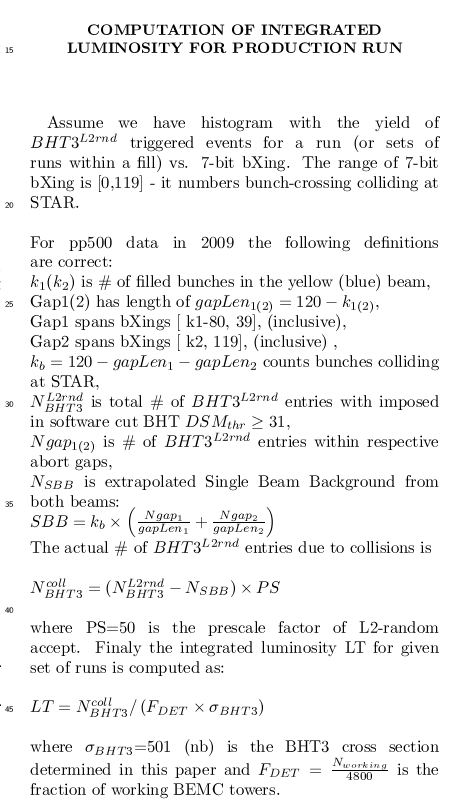- rcorliss's home page
- Posts
- 2013
- January (1)
- 2012
- 2011
- 2010
- December (1)
- October (2)
- September (2)
- August (2)
- June (2)
- May (3)
- April (3)
- March (5)
- February (2)
- January (8)
- 2009
- December (5)
- November (1)
- October (7)
- September (10)
- August (4)
- July (3)
- May (1)
- February (1)
- January (1)
- 2008
- 2007
- My blog
- Post new blog entry
- All blogs
Table of BHT3 luminosities
I've attached a table of the BHT3 luminosities in the L2W dataset. This assumes a cross section of 350 nb for BHT3, which is probably not the final value, since it hasn't been corrected for the fraction of the detector that was live during the vernier scans. When I have an updated table I will post it to this page with a later version number.
The equations used are:
BHT3=(rawBHT3-SBB)*50
L=BHT3 / (Fdet*xs)
rawBHT3=the total number of L2W random accepts
SBB=120* the sum of the average in each abort gap of the number of L2W random accepts per bunch crossing. This approximates the assumed constant single beam backgrounds for each beam.
Fdet=the number of towers with good status as extracted from the status table by Jan, meaning the following three calls returned a '1' in the 'stat' argument:
mBarrelTables->getStatus(jBP, softID, statPed,"pedestal");
mBarrelTables->getStatus(jBP, softID, statOfl);
mBarrelTables->getStatus(jBP, softID, statGain,"calib");
xs=the BHT3 cross section as described above
Zeroes mean the run did not appear in my output - probably the job failed.
Note: In .v1, I've updated the calculation for the Single Beam Background: It's now 109*average of the nine-bin gap + 111*average of the eleven-bin gap. I've also changed the cross section to 369.15nb, which is the average of the result for the two vernier scans. If a different cross section is wanted, you can re-calculate the last column by BHT3/Fdet/xs.
Another Note: in .v2, I've updated the way L2W random accepts are counted. Previously, the bit from the L2Result was checked, but due to concerns that the BHT3 thresholds changed during physics running at some point, it now has implemented the L0 condition in software, checking the ADC of each barrel tower to see if it's >30. This results in an integrated luminosity of 16.302pb^-1
Regarding .v3: Justin pointed out that I was using only the runs with good spin sorting. I have changed the macro to go over 'setABCD'. All other notes still apply.
Regarding 'luminosity.v3' and those that may follow: The cross section has been updated to 501nb and the SBB calculation now takes into account the size and position of each abort gap run-by-run from a static prescription instead of trying to identify each gap dynamically. Several new columns have been added:
RunNumber, trigID, softL0, L2Wr, Gap1, Gap2, Nblue, Nyell, Nsbb, Nbht3, Fdet, L(nb^-1)

In order to better organize what I hope is the final iteration of this, I've made a new blog page which contains the version of the luminosity table that will be used for APS.
- rcorliss's blog
- Login or register to post comments
